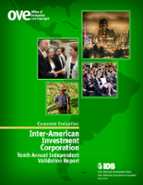Inter-American Investment Corporation: Tenth Annual Independent Validation Report Prepared by the Office of Evaluation and Oversight
Date
Jun 2014
This is the tenth consecutive year that IIC has contractually engaged OVE to support it in implementing a standardized system to account for the developmental and financial results of its investment projects. This system - within which reports like the present one serve to record the results of successive annual batches of mature projects - is compliant with the Good Practice Standards (GPS) for Private Sector Operations issued by the Evaluation Cooperation Group of Multilateral Development Banks (ECG-MDB).This is the tenth consecutive year that IIC has contractually engaged OVE to support it in implementing a standardized system to account for the developmental and financial results of its investment projects. This system - within which reports like the present one serve to record the results of successive annual batches of mature projects - is compliant with the Good Practice Standards for Private Sector Operations issued by the Evaluation Cooperation Group of Multilateral Development Banks.
Shortcomings in the current GPS methodology have given rise to discussions among ECG members, as well as within IDB, on the possible benefits of increased convergence with the standards for evaluation of public sector operations. These discussions are likely to lead to adjustments in the approach to private sector project evaluation.
Given methodological shortcomings in GPS, results in this report should be considered with caution. The report presents the application of the standards to an annual batch of 24 mature projects, corresponding to a total IIC investment of US$187.9 million. Under the current version of the good practice evaluation standards, 79% of projects (US$165.7 million) rated at least mostly successful in Development Outcomes, while Investment
Outcome was rated as satisfactory for 88% of the projects (US$166.2 million in IIC investment).
IIC Work Quality presented mostly favorable results, with 79% of projects (US$171 million in IIC investment) receiving satisfactory ratings. Finally, from this limited project-by-project evaluation perspective, IIC seems to still have added value to a majority of clients: 63% of projects (US$131 million) rated satisfactory in Additionality.
Despite the likelihood of future methodological changes, the discipline brought about by the annual exercises like the one reflected in this report has allowed IIC to strengthen its self-evaluation capabilities over the last decade. In addition, the system has also allowed IIC to identify useful lessons to improve future IIC projects in similar areas, as well as highlight opportunities to increase the reliability of its evaluation system.
Lessons from this report suggest further opportunities to enhance IIC's project appraisal, structuring and supervision processes by fully leveraging IIC's financial and nonfinancial (technical assistance) product offering. These lessons also appeared in prior batches and were the subject of recommendations in last year's report. Instead, this report has a single recommendation: work with OVE to revamp IIC's project evaluation system to address the shortcomings of the current one, while seeking harmonization across IDB's private sector and sovereign guarantee windows. This will likely entail overhauling both IIC's ex-ante project assessment tools (with a view towards enhancing project evaluability) and IIC's project monitoring and ex-post assessment approach.
Shortcomings in the current GPS methodology have given rise to discussions among ECG members, as well as within IDB, on the possible benefits of increased convergence with the standards for evaluation of public sector operations. These discussions are likely to lead to adjustments in the approach to private sector project evaluation.
Given methodological shortcomings in GPS, results in this report should be considered with caution. The report presents the application of the standards to an annual batch of 24 mature projects, corresponding to a total IIC investment of US$187.9 million. Under the current version of the good practice evaluation standards, 79% of projects (US$165.7 million) rated at least mostly successful in Development Outcomes, while Investment
Outcome was rated as satisfactory for 88% of the projects (US$166.2 million in IIC investment).
IIC Work Quality presented mostly favorable results, with 79% of projects (US$171 million in IIC investment) receiving satisfactory ratings. Finally, from this limited project-by-project evaluation perspective, IIC seems to still have added value to a majority of clients: 63% of projects (US$131 million) rated satisfactory in Additionality.
Despite the likelihood of future methodological changes, the discipline brought about by the annual exercises like the one reflected in this report has allowed IIC to strengthen its self-evaluation capabilities over the last decade. In addition, the system has also allowed IIC to identify useful lessons to improve future IIC projects in similar areas, as well as highlight opportunities to increase the reliability of its evaluation system.
Lessons from this report suggest further opportunities to enhance IIC's project appraisal, structuring and supervision processes by fully leveraging IIC's financial and nonfinancial (technical assistance) product offering. These lessons also appeared in prior batches and were the subject of recommendations in last year's report. Instead, this report has a single recommendation: work with OVE to revamp IIC's project evaluation system to address the shortcomings of the current one, while seeking harmonization across IDB's private sector and sovereign guarantee windows. This will likely entail overhauling both IIC's ex-ante project assessment tools (with a view towards enhancing project evaluability) and IIC's project monitoring and ex-post assessment approach.




